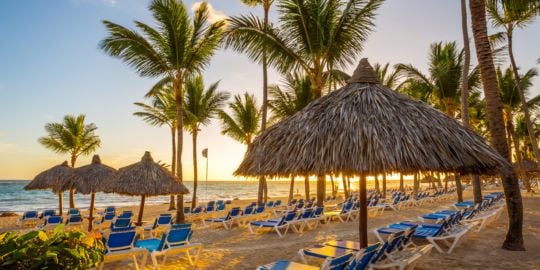I'm a new member and currently visiting the north coast (almost two weeks now) we leave tomorrow. My wife and I have met with Coldwell Banker and working with a lawyer to potentially build on the beach between Sosua and Cabarete. All this information is great. One question I have, is it customary when making an offer and leaving cash with the lawyer in an escrow account to make an offer in good faith? The build would meet the $200k threshold for residency, a few years from now is the plan and it sounds like Lawyer Lily is the one to use for that. We have the building plans concept and a lot picked out. We haven't signed anything and have opened up a bank account in the DR Banco Santa Cruz it is very easy and they were helpful, I was reading another thread about fees etc, this doesn't seem to be an issue here. Any advice would be greatly appreciated, thanks.
Construction cost and potholes
Oh man, I was hoping for a post about potholes.
The 200k into your residence does not by itself qualify for residency. Talk to Lishali, she will tell you straight up how to qualify! And if you don't she will tell you and not charge you huge fees and pretend it will happen!
Listen to Planner (and then Lily) about residency!
As for the escrow, yes - with all three of our purchases, we've had deposits (like earnest money in the US) with our attorney at the time the sales agreement was signed. In the case of our apartment, it was just a $10,000 deposit. For the two properties, it was 10% of the purchase price.
For the property we sold, the attorney (buyer's choice - not ours) did not have an escrow account, so the buyer gave us 10% upfront.
Be very careful when selecting a builder! One thing we've learned here is that people call themselves whatever they want! You built a doghouse? Congratulations - you're a Builder! You helped a friend pick out throw pillows? You're an Interior Designer! You have hands and a bottle of lotion? You're a massage therapist! Okay, I might exaggerate a little, but we were referred to many "builders" who were basically handymen and they were willing to bid on our construction! We were referred to "interior designers" who were party planners, photographers, and anything but decorators. And you will get plenty of referrals from people who have never seen a thing someone has done, but they enjoy having a beer with them, so they must be good, right?
When you meet with real builders, ask to see homes currently in construction (are the workers actually working, or are they sleeping or staring at their phones? is the worksite clean? does it look like the work is being done well and in the right order- you shouldn't see expensive tile already on the floor when grey work is continuing, etc.), homes that have been completed - new completions give you an idea of what will be delivered, older homes show you how well they hold up, and talk directly to people they worked with! Were they easy to work with? Did they stick to budget and timeline? How was the communication?
Building a home is a huge investment in terms of time, energy, and money! You want to choose wisely! We almost got burned, but because we pressed and kept asking questions of previous clients, we escaped what would have been a disaster! It meant a few months delay, but we could not be happier with our ultimate choice in builder. We just met someone yesterday whose home was built by our guy 10 years ago and he couldn't be happier!
Thanks for the advice, we've gone through plans and walked through three homes the builder has built. One was just finishing up the gray stage, so we got to see the walls and electrical conduit run.
I'm familiar with construction and can read plans, even though I have to make the conversations to meters, my father owned a construction company in the states, but definitely much different here. We're working with Coldwell Banker in Sosua,
We still have some boxes to check, but so far seems to be ok. I really appreciate the comment about confirmation of escrow. We've been in contact with a lawyer and met with her, she was recommended by Coldwell.
Great post ddmcghee! Well said.
The square meter of housing construction increases about 30%
https://www.diariolibre.com/economia/el … KM26809434
Building material prices continue to climb upward, which worries home developers and builders, and hardware dealers, putting them in a bad position to close and fulfill a contract.
“It is a situation that we have been denouncing for more than a year, the sustained rise in construction materials, which has reached a point such that, in that period, the cost per square meter of housing construction has skyrocketed by 30% approximately ”, according to Jorge Montalvo, president of the Dominican Association of Home Builders and Promoters ( Acoprovi).
In data provided to Diario Libre , it is observed that products such as PVC pipes have registered increases of 119.09% on average as a category. For example, within this is the SDR26 ½ x 19 PVC pipe, which in March 2020 the unit cost RD $ 41.93 and currently is around RD $ 121.07, for a difference of 188.74%.
On the other hand, the SDR41 3x19 PVC tube, the unit had a cost of RD $ 470.50 in March 2020 and currently stands at RD $ 1,120.00, a difference of RD $ 749.50, marking 159.30% as of June of this year 2021.
In the electrical materials category, an average percentage of 117.77% is registered. In the case of THHN wires numbers 12, 14 and 10, increases of up to 177.34% are observed in the period indicated above. The foot of number 12 cost RD $ 3.45 in March 2020 and now RD $ 9.12, for a difference of 164.73%; THHN wire foot number 14 cost RD $ 2.40 and currently RD $ 6.64, for a 177.34% increase.
Arturo Espinal, president of the Dominican Association of Ironmongers (Asodefe), described the situation that the construction sector is experiencing as difficult and warns that the courts would soon be full of complaints because the price that is established at the time of closing the contracts before Building a home changes at the time of delivery of said property.
“In pre-sale, projects still in model, in plan, start a construction at a price and they have already skyrocketed by 30 and 40%. In the end, what we are going to have are the courts full of lawsuits for breach of contracts, "he said.
He assured that a sector such as construction can be taken as the spearhead for economic reactivation, but that, with this stimulus of increases in inputs, we must listen to the issue.
“Everything that is plastic parts and pipes has exploded by more than one hundred percent. For example, steel or rod, as we call it here in the Dominican Republic, a rod bundle at the beginning of the pandemic last year cost RD $ 40,000, today it is costing RD $ 74,500 to the public, with an increase of more than 80% " said the representative of the hardware store.
In the document obtained through Acoprovi, it is observed that the block unit of five cost RD $ 26.50 in March 2020 and is currently around RD $ 35.00, for an increase of 32.08%; The block of six, the unit was marketed between RD $ 28.00 and RD $ 29.00, now it is dispatched to the public between RD $ 34.00 and RD $ 37.00 for a variation above 27% and the unit of block of eight was sold at RD $ 35.00 and in The 15-month pandemic registered an increase of RD $ 12.00, for a rise of 34.29%.
In addition, the aggregates register, on average, an increase of 41.67%. In the case of Itabo sand, the cubic meter was sold at RD $ 700.00, currently it is available at RD $ 1,050.00, for an absolute variation of RD $ 350.00 and a relative variation of 50%. On the other hand, the cubic meter of gravel is now shipped at RD $ 1,000, 25% more than what it cost in March 2020, and the blue sand, the cubic meter was sold at RD $ 1,200.00, currently it is sold at RD $ 1,800, for 50% more than last year.
In the case of the cement unit (cover), this registered an increase of 31.10%, going from RD $ 283.00 to RD $ 371.00.
Wood, which is widely used in the construction sector, registers increases that range from 39.47% to 438.98%, as is the case of one-sided plywood, it went from costing RD $ 930.02 at the beginning of the pandemic to RD $ 5,012.64 in currently, for an absolute variation of RD $ 4,082.62 as of June 2021.
Other materials that have registered increases are: interconnection (electrical), on average they registered increases of 62.36%, nails 97.28%, paints 37%, blacksmithing registered increase on average of 44%, the cubic meter of industrial concrete a 23.46%, others 34.16%.
Having just placed contracts on $2.5m of construction work on a nearby island, I can assure you that construction material prices are very volatile and moving upward sharply such that bidders held their prices for very short periods and demanded advance payments to purchase materials now. As mentioned PVC pipe and copper cables have moved significantly along with all types of wood.
Those building a house or who have made pre-build contracts may be looking at significant increased costs.
I should add that the delivery times for imported materials from the USA are now much longer too. Those building here, should focus your building design on locally sourced and made materials is my suggestion, and procure soonest.
lennox we were recently chatting with our construction agent and he brought up using M2 prefab walls and ceilings in place of traditional concrete and rebar. He indicated it may be no less costly; however, they are having trouble sourcing concrete building materials, namely sand and other aggregates, and M2 would be faster to stand up. Utilities would be easier to install as well. It drives me crazy to think they normally saw and chisel into walls and floor to set the electrical lines. 
I am somewhat familiar with prefab structures, but had to do some research to get comfortable with the M2 product. So far it sounds promising, other than the environmental impact, which interestingly our builder touts as an advantage of M2. Not in the least.
Our builder has built with this product in the past, which was my first question to him. Also, the Puerto Plaza buildings in Las Terrenas, which people refer to as "the ships", were built with M2 apparently.
Rocky, I think somewhat traditionally here in the Caribbean because we are located in a hurricane and earthquake zone.
I am not familiar with M2 that you mention.
My experience of seeing the wind and especially water damage to prefabricated and non masonry construction as a loss adjusters building surveyor in St Croix, St Thomas and PR after Maria and Irma, leads me to give it a very wide bearth. All the masonry buildings fared very much better was my conclusion.
I also question the capabilities of prefabricated construction in a significant earthquake, whereas design codes for concrete and masonry design here have been updated after the Haiti quake of 2010, and in LT you have good rock foundations.
I don't understand that there is a shortage of aggregates where you are located with a very large quarry near Sanchez - on the oposite side of the hills to Coson. And then we have several cement making plants in DR and rebar is rolled here too and Khoury blocks are made locally.
Conduits and pipes tend to be set in the blockwork voids here and the cut outs are made at the outlet points rather than post chasing. Ultimately all is plastered over.
My other question concern would be rodent and insect infestation especially if you are building in the campo. you can treat the substructure and perimeters with anti termite chemicals but pests still find a way to breach non masonry construction and any voids better imo.
Again I repeat I am a traditionalist and favour the preferred construction methods in the Caribbean (where I have worked in construction for 20 years in building design and construction), and that will exclude timber roofing and non masonry wall constructions. Others may be more open to alternatives and that is their choice.
Granted I have limited construction experience here but I can't disagree with anything you have said. The research I have done seems to indicate M2 structures are quite strong and apparently more earthquake resistant; however, it is important to separate fact from sales conjecture. Water infiltration would be my primary concern at this point. That and to quote Liam Neeson.....it takes a "very particular set of skills" to construct with prefab.
DR is not immune to the global problems affecting material prices and the big increases in construction costs are to be expected. And delays!
As I have written here before my actual cost of building a single level masonry building with flat concrete roof in the campo with my own material purchases and labour only maestros was $30 per square foot in 2019 and first half of 2020 and it is reasonable from what I have seen buying materials for various small extensions that the costs of basic materials and especially electrical and plumbing goods have gone up perhaps by a quarter or more. Inflation in DR is apparently just over 6% and fuel costs too have rocketed with consequential knock on effects.
If you are using a builder he should only be passing on the material element of the cost increases which would be about one third of the total cost. So perhaps 15% increase per square foot or less. It is still alot to add to your budget.
The knock on effect will probabaly come with rental costs in the property sector soon.
The price of homes rises up to 30% per square meter
https://www.diariolibre.com/economia/el … GG29940060
The rise in the prices of construction materials caused the cost of homes in the Dominican Republic to skyrocket between 25% and 30% during the last year, per square meter, as revealed by the president of the Dominican Association of Builders and Housing Promoters (Acoprovi).
Jorge Montalvo, head of Acoprovi, explained that the rising cost of building inputs meant that a house that previously cost RD $ 2 million currently has a price of RD $ 2.5 million on the market.
Montalvo said that in many cases, home developers have had to assume an important part of the increases in materials, although he warned that new projects will reflect the changes that have occurred in the price of the square meter of construction.
"We estimate that with the increases that have been taking place since last year in this part, with materials that have shot up to 120%, that translates into the cost of the square meter of construction has shot up in that period in 25-30%, which is an important number ”, he detailed.
The low-cost ones, the most affected
The rise in the square meter has had an impact on all segments, since construction materials, such as cement and rebar, are among the most widely used at a general level, but they are also the ones that have increased the most.
However, he stressed that one of the most affected projects is the low-cost one, due to the high amount of cement and rebar with which they have to work to achieve the final work and the price may vary for the portion of finishing materials that you need. .
"But in the end they are having an increase in all lines," he added.
He maintained, however, that the construction sector is at its best, because demand has grown, especially in low-cost areas and they expect that next year it will increase more.
He specified that one of the great challenges facing the sector is precisely the issue of construction materials and their stability in the market.
"The sector is doing well and expectations are good, interest rates are competitive, it means that the elements are in place for the sector to continue growing," he said
As a follow-up to my previous postings, our builder, without notifying us, decided to build our main floor with traditional concrete block. He completely discarded the M2 construction that we agreed on. We did not know this until we visited the site one day. I was quite disappointed, but in the end it is fine. My simple advice is keep a watchful eye on your builder and visit your construction site regularly. I would not recommend building here without being able to visit the site on a regular basis.
If he is working to structural engineering drawings he should be following them and any changes need to be ageed with you the client. You are building in an active siesmic zone so stick to the design, get the designer to agree to changes formally or ask him to take legal liability for changes.
You are paying a premium for the builders expertise and professionalism so dont be shy demanding it.
When yo do it yourself as I did you take on those risks.
Yes you should be checking construction regularly and especially during the structural work. At least twice a week and be there before and for major concrete pours. I was insistent on signing off pours having checked rebar, forms, roughing in etc. If not ask for site photos or videos. Keep a photographic record throughout the works in case of future dispute.
Could you please kindly advise on your builder? thank you in advance! Best wishes, Anna
Interesting article on Dominican Today
Puerto Rico offers thousands of jobs to Dominicans
After hurricanes, Irma and Maria devastated the island in 2017 and several earthquakes following those events, Puerto Rico is recovering.
Santo Domingo, DR
With the allocation of US$85 billion in federal funds for the reconstruction of Puerto Rico, after the devastation caused by natural phenomena and the implementation of the debt adjustment plan, the island of enchantment has become a business and employment platform for different countries, with a significant interest in Dominicans.
They are already requesting Dominican workers such as masons, carpenters, floor layers, master builders, electricians, and other construction areas. This sector will start 2,000 projects this year, of 11,000 to be completed by 2032, with a labor deficit of about 60,000 workers.
They are also requesting construction companies and companies in the electricity sector to set up on the island or partner with those of the Puerto Rican capital.
Hurricanes Irma and Maria devastated the island in 2017, and several subsequent earthquakes caused extensive damage.
The executive director of the Puerto Rican Government Office in the Dominican Republic, Nelson Torres Martínez; the Dominican consul in the Commonwealth, Opinio Díaz, and the deputy minister of Consular and Migratory Affairs of the Foreign Ministry, Jatzel Román, offered the details in an exclusive interview for Listin Diario.
This follows the signing of a joint declaration of a strategic alliance between President Luis Abinader and the Governor of Puerto Rico, Pedro Pierluisi, last December, which updates the Aguadilla agreement of 2009 to boost bilateral relations and promote manufacturing, increasing agricultural technologies, construction, and services.
When asked what Borinquen needs in the immediate future, Torres Martinez said, “equipment, personnel, and supplies. There have been conversations with about 70 people from different companies here, telling them what we have, where the money is, and what the projects are, with an open invitation for them to come to Puerto Rico, either to establish themselves or to form a partnership with companies that are already set in Puerto Rico.
He said his government offers legal guarantees for foreign companies to be competitive.
“In terms of guarantees, I can tell you that Puerto Rico is one of the countries, as a territory of the United States, that has the best legal security. We are part of the U.S. system, we are also part of the federal government, and there is all the guarantee that could be in any U.S. territory.”
Hospitals and electrical system
He mentioned that they have the design for the Vieques hospital for a population of 10,000 people, and it is a $50 million project. There is also the trauma hospital that will be built in San Juan, a project of almost $500 million, and roads, highways, housing, and others.
Besides the carts, bridges, dams, the electrical system was destroyed by natural phenomena. Torres indicated a reconstruction process for which they have 9,500 million dollars, including supply, cables, poles, labor, and the managerial part.
Infotep will provide other workers.
“Right now, we are working with the request for 320 construction workers. I have just written to the Instituto de Formación Técnico Profesional (infotep), so that they will be responsible,” said Consul Díaz.
He said that with this bank of human resources, they are preparing names of qualified personnel to present them to the companies, as in the case of the 320 required by a single company.
The Dominican said that the minimum wage in Puerto Rico when it is with federal resources, as in these cases, is $15 an hour, which in his opinion will impact the country with the remittances.
On visas
In Puerto Rico, there are about 3.2 million inhabitants, of which 10% are Dominicans (300,000), and 70% have uncertain immigration status. Therefore, they do not qualify to be hired for these works; the consul pointed out.
The personnel demanded the reconstruction of Puerto Rico require a temporary work visa. Still, the Dominican Republic is only included in the H2B visa program for non-agricultural workers. The U.S. State Department has 66,000 per fiscal year, distributed among the qualifying nations.
In this sense, they pointed out that through the Department of State of Puerto Rico they are taking other steps to try to ensure that Dominicans who go to the island to work are not in that category but are included in Parole, which is a special permit that the United States allows them to work for a short period without restrictions.
H2B Visa
Dominican Deputy Foreign Minister Jatzel Román highlighted the efforts made by the Ministry of Foreign Affairs so that Dominicans could be included again in the H2B visa and recalled that the cessation was due to extended stays.
In November 2021, the Dominican Republic was again included in the H2B visa program for non-agricultural workers, “which is a good opportunity that if taken advantage of in the most orderly way possible opens up many more opportunities. We cannot go back to demurrage.”
He noted an excellent opportunity between the two countries, better than the so-called “golden era” from the 1950s to the 1990s, where there was a creative impact. “That model of tax exemption was established in Puerto Rican territory, there came a time when to finish the products, plants were established here in the DR.”
WHAT DOES THIS MEAN?
Likely the best construction workers are going to go where the money is! And the ripple effect means prices will go up here for the good labor!
planner wrote:Interesting article on Dominican Today
...
WHAT DOES THIS MEAN?
Likely the best construction workers are going to go where the money is! And the ripple effect means prices will go up here for the good labor!
I'm glad our construction is wrapping up!
@planner i took advantage of the PPP myself. It may not be the correct choice of word but yes if you had a case which most of them in the service industry did (suffered because covid shut their businesses down). Only drawback is the money is meant to help the business pay employees and bills. Well some of them did so but others were "creative" . At the end of the day it was free money to be taken
@ddmcghee personally i know of a few. Sorry your pops failed to get his hands on one. As we speak there are still programs being offered on the local radio for those hit by covid. And we ask where the inflation is coming from. $30 trillion and counting in debt!!!
@planner The money referred to as PPP has very specific usage requirements, if people chose to break the law and do something else with it, I certainly hope they get audited and it now becomes a loan that needs to be repaid. I have first-hand knowledge of the process . My family followed the letter and spirit of the program.









